
The subphylum Chelicerata constitutes one of the major subdivisions of the phylum Arthropoda. Chelicerates include the sea spiders, horseshoe crabs, and arachnids, as well as a number of extinct lineages, such as the eurypterids and chasmataspidids.
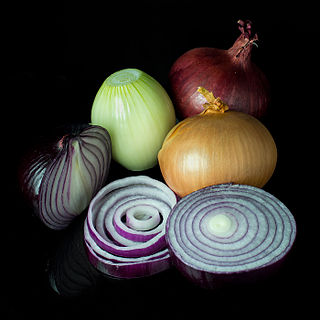
An onion, also known as the bulb onion or common onion, is a vegetable that is the most widely cultivated species of the genus Allium. The shallot is a botanical variety of the onion which was classified as a separate species until 2011. Its close relatives include garlic, scallion, leek, and chive.

In botany, a bulb is structurally a short stem with fleshy leaves or leaf bases that function as food storage organs during dormancy.

Lilium is a genus of herbaceous flowering plants growing from bulbs, all with large prominent flowers. They are the true lilies. Lilies are a group of flowering plants which are important in culture and literature in much of the world. Most species are native to the Northern Hemisphere and their range is temperate climates and extends into the subtropics. Many other plants have "lily" in their common names, but do not belong to the same genus and are therefore not true lilies.

Narcissus is a genus of predominantly spring flowering perennial plants of the amaryllis family, Amaryllidaceae. Various common names including daffodil, narcissus and jonquil, are used to describe all or some members of the genus. Narcissus has conspicuous flowers with six petal-like tepals surmounted by a cup- or trumpet-shaped corona. The flowers are generally white and yellow, with either uniform or contrasting coloured tepals and corona.

Biological control or biocontrol is a method of controlling pests, whether pest animals such as insects and mites, weeds, or pathogens affecting animals or plants by using other organisms. It relies on predation, parasitism, herbivory, or other natural mechanisms, but typically also involves an active human management role. It can be an important component of integrated pest management (IPM) programs.

Mites are small arachnids. Mites span two large orders of arachnids, the Acariformes and the Parasitiformes, which were historically grouped together in the subclass Acari. However, most recent genetic analyses do not recover the two as each other's closest relative within Arachnida, rendering the group non-monophyletic. Most mites are tiny, less than 1 mm (0.04 in) in length, and have a simple, unsegmented body plan. The small size of most species makes them easily overlooked; some species live in water, many live in soil as decomposers, others live on plants, sometimes creating galls, while others again are predators or parasites. This last type includes the commercially destructive Varroa parasite of honey bees, as well as scabies mites of humans. Most species are harmless to humans, but a few are associated with allergies or may transmit diseases.
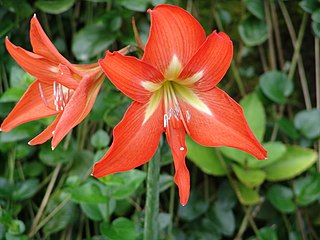
Hippeastrum is a genus of about 90 species and over 600 hybrids and cultivars of perennial herbaceous bulbous plants. They generally have large fleshy bulbs and tall broad leaves, generally evergreen, and large red or purple flowers.

Tetranychus urticae is a species of plant-feeding mite generally considered to be a pest. It is the most widely known member of the family Tetranychidae or spider mites. Its genome was fully sequenced in 2011, and was the first genome sequence from any chelicerate.

Spider mites are members of the Tetranychidae family, which includes about 1,200 species. They are part of the subclass Acari (mites). Spider mites generally live on the undersides of leaves of plants, where they may spin protective silk webs, and can cause damage by puncturing the plant cells to feed. Spider mites are known to feed on several hundred species of plants.
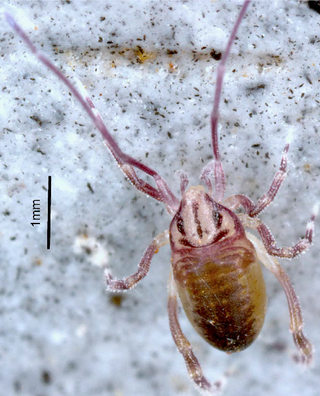
Opilioacaridae is the sole family of mites in the order Opilioacarida, made up of about 13 genera. The mites of this family are rare, large mites, and are widely considered primitive, as they retain six pairs of eyes, and abdominal segmentation. They have historically been considered separate from other mites belonging to Acariformes and Parasitiformes, but are now generally considered a subgroup of Parasitiformes based on molecular phylogenetics.
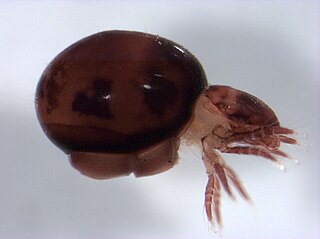
Oribatida, also known as oribatid mites, moss mites or beetle mites, are an order of mites, in the "chewing Acariformes" clade Sarcoptiformes. They range in size from 0.2 to 1.4 millimetres. There are currently 12,000 species that have been identified, but researchers estimate that there may be anywhere from 60,000 to 120,000 total species. Oribatid mites are by far the most prevalent of all arthropods in forest soils, and are essential for breaking down organic detritus and distributing fungi.

Tulips (Tulipa) are a genus of spring-blooming perennial herbaceous bulbiferous geophytes. The flowers are usually large, showy, and brightly coloured, generally red, orange, pink, yellow, or white. They often have a different coloured blotch at the base of the tepals, internally. Because of a degree of variability within the populations and a long history of cultivation, classification has been complex and controversial. The tulip is a member of the lily family, Liliaceae, along with 14 other genera, where it is most closely related to Amana, Erythronium, and Gagea in the tribe Lilieae.

Brithys crini, the amaryllis borer, crinum borer, lily borer or Kew arches, is a moth of the family Noctuidae. It is a garden pest in parts of its range, as their larvae damage the stems and leaves of lilies, especially lilies of the family Amaryllidaceae.

Pyemotes tritici is a species of mite known as the grain itch mite or straw itch mite. It is a cosmopolitan species that is found on straw, hay and stored grain. It is a parasite of small arthropods and is being investigated as a possible biological control of stored product pests. It is associated with dermatitis in humans, and it causes an itchy rash.

Rhizoglyphus is a genus of mites in the family Acaridae. It has a worldwide distribution and is often associated with the bulbs, corms or tubers of plants.

Subir Kumar Ghosh (1932–2008) was an Indian structural geologist and an emeritus professor at Jadavpur University. He was known for his studies on theoretical and experimental structural geology and was an elected fellow of the Indian National Science Academy, and the Indian Academy of Sciences. The Council of Scientific and Industrial Research, the apex agency of the Government of India for scientific research, awarded him the Shanti Swarup Bhatnagar Prize for Science and Technology, one of the highest Indian science awards for his contributions to Earth, Atmosphere, Ocean, and Planetary Sciences in 1977.
Eriophyes tulipae, commonly known as the dry bulb mite, is a species of mite in the genus Eriophyes. This mite feeds on members of the lily family, and has damaged garlic crops. At one time, it was also thought to feed on wheat and other grasses, but the wheat curl mite is now regarded as a different species, Aceria tosichella.

Stigmaeidae is a family of prostigmatan mites in the order Trombidiformes. At over 600 species, it is the largest family in superfamily Raphignathoidea. It has a worldwide distribution.
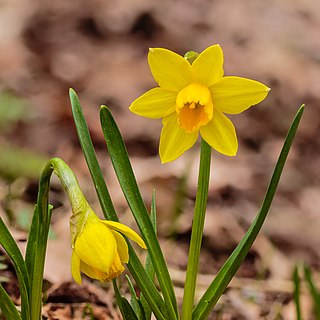
Narcissus 'Tête-à-tête' is a hybrid cultivar of Narcissus, which was introduced in 1949. It is one of 110 cultivars produced by British daffodil breeder Alec Gray. 'Tête-à-tête' is a popular ornamental plant, which is known for its very early flowering period and short stature. This cultivar is commonly used as a garden plant where it can be planted in pots, rock gardens, garden borders and even naturalized in lawns. The cultivar name 'Tête-à-tête' means to have a conversation between two people, which relates to the cultivar often hosting a pair of flowers per stem.


















